|
This is the third part of the Hispanic Medal of Honor series which
consists of the short biographies of World War II recipients Harold
Gonsalves, David M. Gonzalez, Silvestre S. Herrera and Jose M. Lopez.
David Gonzales, Jr. and his wife attended a ceremony for war heroes,
honoring his father David M. Gonzales and other heroes celebrated in
Santa Ana, California in 1999. When they saw the fliers sent out by the
Army, they realized the image on the fliers which was supposed to
represent their father was of somebody else's. The family tried to get
the Army to correct the error, however the Army did nothing until Fred
Flores, an aide to Congressman Howard Berman investigated the situation.
Not only did Flores discover that another image was erroneously
displayed in the Pentagon's Hall of Heroes, but that there were many
other medals, including a Bronze Star Medal which Gonzales had earned.
The situation was finally corrected, but get this, Congressman Howard
Berman presented the family with the decorations in a public ceremony
and received all of the credit when it was really his aide Fred Flores
who did all of the work.
Medal of Honor recipient Silvestre S. Herrera was the first resident
of Arizona to be awarded the medal. The thing that makes Herrera unique
is the fact that he is the only living Medal of Honor recipient
authorized to wear both the Medal of Honor and Mexico's Order of
Military Merit (first class).
* N.B. An asterisk after the name indicates that the award was given
posthumously.
Harold Gonsalves*
By: ERcheck
PFC Harold Gonsalves Medal of Honor
(Navy & Marine version)
Private First Class Harold Gonsalves (1926-1945) was a United States
Marine who sacrificed his life to save fellow Marines in the Battle of
Okinawa during World War II. For his heroism on this occasion, he was
posthumously awarded the highest military honor of the United States -
the Medal of Honor.
Early years
Harold Gonsalves was born in Alameda, California, on January 28,
1926. He attended school at Alameda and after two and one half years of
high school, quit to take a job as a stock clerk with Montgomery Ward
and Company in Oakland, California. In high school he had taken part in
football, baseball, track, and swimming, and sang tenor in the school
glee club.
Marine Corps service
Gonsalves enlisted in the Marine Corps Reserve on May 27, 1943 and
was called to active duty on June 17, 1943. He went through recruit
training at the Marine Corps Recruit Depot San Diego, California, and
then, at his own request, was sent to the Raiders at Camp Pendleton,
California. After three weeks with them, he was transferred to the
artillery at the same camp. He was classified as a cannoneer on 75 and
105 millimeter guns before he joined the 30th Replacement Battalion in
the fall of 1943. Pvt Gonsalves left the United States on November 8,
1943 and at the end of that month was assigned to the 2nd Pack Howitzer
Battalion, which was then in Hawaii. He was promoted to private first
class in March 1944 and with his battalion became part of the 22nd
Marines two months later.
With the 22nd Marines, he participated in the assault, capture, and
occupation of Engebi and Parry Islands, in the Marshall Islands. At
Engebi, the Marines took the island in six hours, killing more than one
thousand of the enemy. The regiment was cited by MajGen Thomas E.
Watson, commanding general of Tactical Group I, for their part in the
Marshalls' campaign. From Eniwetok, PFC Gonsalves accompanied the 22d
Marines to Kwajalein, to Guadalcanal, back to Kwajelein and Eniwetok,
then up to Guam in July where he took part in the liberation of that
pre-war American island.
After Guam, the regiment went back to Guadalcanal, where in November
they were detached from the 22nd Marines and joined the 15th Marines of
the 6th Marine Division. It was with that outfit that PFC Gonsalves
landed on Okinawa on April 1, 1945.
Two weeks later, on 15 April, the 19-year-old Marine was a member of
an eight-man forward observer team which was engaged in directing
artillery fire in support of an attack by the infantry on Japanese
positions on Motobu Peninsula. When it finally became necessary for the
team to advance to the actual front lines, the officer in charge took
PFC Gonsalves and one other man with him. PFC Gonsalves was acting Scout
Sergeant of the team. He and the other Marine were to lay telephone
lines for communication with the artillery battalion.
As the team advanced to the front, they were brought under heavy
enemy rifle, grenade and mortar fire. Just as the three had reached the
front lines, a Japanese grenade landed among them. It was less than a
foot from the two Marines with PFC Gonsalves. Without a moment's
hesitation, he flung himself on the deadly missile, taking the full
explosion into his own body. He gallantly gave his life for his fellow
Marines and his country. The other two were not even touched by grenade
fragments and they successfully completed their mission.
The Medal of Honor, with citation signed by President Harry S.
Truman, was presented on June 19, 1946 to PFC Gonsalves' sister in the
presence of his parents at ceremonies in the office of the commanding
general of the Department of the Pacific, MajGen Henry L. Larsen, USMC
in San Francisco, California.
Following the war, PFC Gonsalves' remains were returned to the United
States for reinterment. He was buried with full military honors in the
Golden Gate National Cemetery in San Bruno, California, March 20, 1949.
Medal of Honor citation: PRIVATE FIRST CLASS HAROLD GONSALVES
UNITED STATES MARINE CORPS RESERVE
Citation:
"For conspicuous gallantry and intrepidity at the risk of his
life above and beyond the call of duty as Acting Scout Sergeant of a
Forward Observer Team, serving with Battery L, Fourth Battalion,
Fifteenth Marines, Sixth Marine Division, during action against enemy
Japanese forces in Okinawa Shima in the Ryūkyū Chain, April
15, 1945. Undaunted by the powerfully organized opposition encountered
on Motobu Peninsula during a fierce assault waged by a Marine infantry
battalion against a Japanese strong-hold, Private First Class Gonsalves
repeatedly braved the terrific hostile bombardment to aid his Forward
Observation Team in directing well-placed artillery fire and, when his
commanding officer determined to move into the front lines in order to
register a more effective bombardment in the enemy's defensive position,
unhesitatingly advanced uphill with the officer and another Marine
despite a slashing barrage of enemy mortar and rifle fire. As they
reached the front, a Japanese grenade fell close within the group.
Instantly Private First Class Gonsalves dived on the deadly missile,
absorbing the exploding charge in his own body and thereby protecting
the others from serious and perhaps fatal wounds. Stouthearted and
indomitable, Private First Class Gonsalves readily yielded his own
chances of survival that his fellow Marines might carry on the
relentless battle against the fanatic Japanese and his cool decision,
prompt action and valiant spirit of self-sacrifice in the face of
certain death reflect the highest credit upon himself and the United
States Naval Service. He gallantly gave his life in the service of his
country."
References:
William Kouts, was the soldier David M. Gonzales was
digging out when he was shot and killed by sniper fire.
This article incorporates text in the public domain from the United
States Marine Corps.
"Private First Class Harold Gonsalves, USMCR", Who's Who in
Marine Corps History, History Division, United States Marine Corps.
Medal of Honor citation
David M. Gonzales*
By Tony (The Marine) Santiago
PFC David M. Gonzales Medal of Honor
(Army version)
Private First Class David M. Gonzales (June 9, 1923-April 25, 1945)
was a United States Army soldier who was posthumously awarded the Medal
of Honor - the United States' highest military decoration - for his
heroic actions during World War II. On December 8, 1945, at age 22, PFC
Gonzales was killed in action in the Philippines while, in the face of
fierce enemy machine gun fire, digging out fellow soldiers who had been
buried in a bomb explosion.
Early years
David Gonzales, born in Pacoima, California, was one of 14 children
born to Mexican immigrants. He joined the U.S. Army at the recruiting
station in his hometown at the outbreak of World War II. On December
1944, he was assigned to Company A, 127th Infantry, 32nd Infantry
Division and sent to combat in the Philippines. He left behind his
family, which included his mother Mrs. Rita Gonzales Duarte, his wife
Steffanie and his newborn son David Jr.
World War II
On February 1, 1945, Gonzales, after only a few weeks with his
division, was awarded the Combat Infantryman Badge. On April 25, 1945,
Gonzales' company found itself engaged in combat against Japanese forces
at Villa Verde Trail on Luzon island in the Philippines. A 500-pound
bomb smashed into the company's perimeter, burying alive five men.
Gonzales and his commanding officer rushed to the buried men's rescue.
His commanding officer was killed by enemy machine gun fire while
Gonzales was digging out the men using a shovel and his bare hands. In
an attempt to dig faster, Gonzales stood up, exposing himself to enemy
fire. With his actions he was able to rescue three of the men before he
was hit and mortally wounded.
On December 8, 1945, President Harry S. Truman, posthumously awarded
the Medal of Honor to Gonzales, presenting the medal to his surviving
family.
On February 2, 1949, Gonzales' body arrived in a funeral train to San
Fernando, California where he was laid to rest.
Medal of Honor citation: Pvt. David M. Gonzales
Rank and organization: Private First Class, U.S. Army, Company A,
127th Infantry, 32d Infantry Division.
Place and date: Villa Verde Trail, Luzon, Philippine Islands, 25
April 1945.
Entered service at: Pacoima, California
Birth: Pacoima, California
G.O. No: 115, 8 December 1945.
Citation:
"He was pinned down with his company. As enemy fire swept the
area, making any movement extremely hazardous, a 500-pound bomb smashed
into the company's perimeter, burying 5 men with its explosion. Pfc.
Gonzales, without hesitation, seized an entrenching tool and under a
hail of fire crawled 15 yards to his entombed comrades, where his
commanding officer, who had also rushed forward, was beginning to dig
the men out. Nearing his goal, he saw the officer struck and instantly
killed by machinegun fire. Undismayed, he set to work swiftly and surely
with his hands and the entrenching tool while enemy sniper and
machinegun bullets struck all about him. He succeeded in digging one of
the men out of the pile of rock and sand. To dig faster he stood up
regardless of the greater danger from so exposing himself. He extricated
a second man, and then another. As he completed the liberation of the
third, he was hit and mortally wounded, but the comrades for whom he so
gallantly gave his life were safely evacuated. Pfc. Gonzales' valiant
and intrepid conduct exemplifies the highest tradition of the military
service."
Controversy:
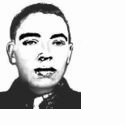
This photo was erroneously displayed in the Pentagon's Hall of Heroes and was replaced with the
photo shown at the top of the page.
In 1999, David Gonzales, Jr. and his wife Bea attended a ceremony for
war heroes in Santa Ana, California. There they discovered that the
picture the Army was sending out to military ceremonies was not of his
father, but of someone else. Gonzales Jr. wrote to the Army in
Washington, D.C. to tell them of their mistake, but did not receive a
response. He then wrote to Congressman Howard Berman, who in turn
referred the letter to his aide Fred Flores. Flores, who was also from
Pacoima, California, immediately called Pentagon officials and had them
correct the mistake. However, the controversy did not end there. Flores
found out that the family had only been presented with a Medal of Honor
and a duplicate Purple Heart Medal (The original one was stolen) and he
realized that there were many other medals, including a Bronze Star
Medal which Gonzales had earned.
During a November 7, 2002 ceremony at Los Angeles Mission College,
Congressman Berman presented David Gonzales, Jr. the following medals
earned by his father: the Bronze Star Medal, the Purple Heart Medal, the
World War II Victory Medal, the Asiatic-Pacific Campaign Medal with two
Bronze Service Stars, the Philippine Liberation Medal, the World War II
Honorable Service Lapel Button, the Combat Infantryman Badge, the Expert
Rifle Badge, and the Gold Star Lapel Button that identifies the next of
kin of members of the military who lost their lives while engaged in
action.
The photo of a soldier who was not Gonzales, but identified as that
of the medal winner and that was erroneously displayed in the Pentagon's
Hall of Heroes was removed and replaced with a correct one of Gonzales
after the renovations of the Pentagon - made necessary by the 9/11
attack - were completed on March 31, 2003.
In memory
In honor of David M. Gonzales, Pacoima Park in Los Angeles County,
California was renamed David M. Gonzales/Pacoima Recreational Center.
The local Army recruiting station there also carries his name, as does a
county Probation Department camp in Malibu.
Awards and recognitions
Among Pvt. David M. Gonzales' decorations and medals were the
following:
Medal of Honor
Bronze Star Medal
Purple Heart Medal
Asiatic-Pacific Campaign Medal with two Bronze Service Stars
Philippine Liberation Medal
World War II Victory Medal
Special Note: William Kouts,
was the soldier David M. Gonzales was digging out when he was shot and
killed by sniper fire. His daughter, Maribeth wrote to me with the
following request: "My Dad is 85 and in ill health and we want to
get into contact with the Gonzales family before Dad's passing so that
Dad can tell David Jr. of his father's heroics firsthand." If any
of our readers know how we can get in touch with Gonzales' family and
make this request a reality, please get in touch with me via e-mail
"NMB 2418@aol.com or with Kouts daughter, Maribeta at mbkouts@bellsouth.net.
Thank you.
References:
^ "Funeral of Pfc. David M. Gonzales", Los Angeles Times,
February 3, 1949.
^ David M. Gonzales Medal of Honor citation. HomeofHeroes.com.
^ a b Dennis McCarthy. "Medal of Honor Winner's Son Finally Gets
dad's Due", Daily News, November 7, 2002.
^ Family of Hometown Hero Presented with War Medals. Los Angeles
Mission College (November 7, 2002).
Silvestre S. Herrera
By Tony (The Marine) Santiago
PFC
Silvestre S. Herrera Medal of Honor
(Army version)
PFC Silvestre S. Herrera (born July 17, 1917) was a member of the
United States Army of Hispanic heritage who was awarded the Medal of
Honor for his heroic actions during World War II in Mertzwiller, France.
His one-man charge on an enemy stronghold resulted in his single-handed
capture of eight enemy soldiers. He is the only living person authorized
to wear both the Medal of Honor and Mexico's Order of Military Merit
(first class).
Early years
Herrera was born in the Mexican city of Camargo, Chihuahua, and not,
as he once believed, in El Paso, Texas. His parents died when he was
only a year old, and the man he had always thought was his father was
really an uncle who had brought the 18-month old Herrera to El Paso to
provide him with a better way of life in the United States. This fact
was unknown to him until he was 17 years old. Herrera worked as a farm
hand in El Paso. He soon moved to Phoenix, Arizona with his wife Ramona
and three children, Mary, Elva, Silvestre, Jr. and the uncle he believed
to be his father. Herrera was a member of the Texas National Guard, 36th
Division. When the United States entered World War II, his unit was to
be one of the first to land in Europe. When he broke the news to his
family, he was told the truth about his parents' death and his place of
birth.
World War II
On March 15, 1945 Herrera's unit found itself engaged in combat in a
forest in the vicinity of Mertzwiller, France. His platoon came under
heavy enemy fire from the woods, forcing most of the men to seek cover.
Herrera charged the enemy stronghold and ended the threat, resulting in
his single-handed capture of eight enemy soldiers.
Later that same day, his platoon came under fire and was attacked by
a second enemy stronghold. The platoon found itself pinned down and the
situation was difficult because there was a mine field between the
platoon and the enemy. Herrera entered the mine field with the intention
of attacking the enemy stronghold while drawing enemy gunfire away from
his comrades. A mine exploded and shattered his leg. Then another mine
exploded, severing his good leg below the knee. Herrera continued to
fire upon the enemy with his own rifle, an act which allowed the members
of his platoon to skirt the mine field and capture the enemy position.
As Herrera lay in the Army hospital recovering from his wounds,
President Truman was not sure that Herrera would be well enough for a
formal presentation of the Medal of Honor. However, on August 23, 1945,
Silvestre wheeled his wheel chair across the White House lawn so that
the President could present him with his award.
Medal of Honor citation: President Truman with Silvestre S. Herrera
Silvestre S. Herrera
Rank and organization:
Private First Class, U.S. Army, Company E, 142d
Infantry, 36th Infantry Division.
Place and date:Near Mertzwiller, France, 15 March 1945.
Entered service at:Phoenix, Arizona
G.O. No.: 75, 5 September 1945.
Citation:
"He advanced with a platoon along a wooded road until stopped by
heavy enemy machinegun fire. As the rest of the unit took cover, he made
a 1-man frontal assault on a strongpoint and captured 8 enemy soldiers.
When the platoon resumed its advance and was subjected to fire from a
second emplacement beyond an extensive minefield, Pvt. Herrera again
moved forward, disregarding the danger of exploding mines, to attack the
position. He stepped on a mine and had both feet severed but, despite
intense pain and unchecked loss of blood, he pinned down the enemy with
accurate rifle fire while a friendly squad captured the enemy gun by
skirting the minefield and rushing in from the flank. The magnificent
courage, extraordinary heroism, and willing self-sacrifice displayed by
Pvt. Herrera resulted in the capture of 2 enemy strongpoints and the
taking of 8 prisoners."
Currently
A year after he was presented with the Medal of Honor, the Mexican
Government presented Herrera with its Order of Military Merit, first
class. He is the only living person authorized to wear both the U.S.
Medal of Honor and the Mexican Order of Military Merit.
Herrera became the first resident from Arizona to receive the Medal
of Honor during World War II. Arizona Governor Sidney P. Osborn declared
August 14, 1945 to be "Herrera Day" and welcomed home Pfc.
Silvestre S. Herrera with a hero's parade. A drive to bestow upon him
citizenship of the only country he knew was started and as a result he
was granted U.S. Citizenship. The citizens of Arizona raised $14,000 to
provide him and his growing family with a new home.
Valle Del Sol, Inc. recognized him with a Special Recognition Award
in 1994, and with a Hall of Fame award in 1999. On March 13, 1996,
Herrera was honored by the United States House of Representatives upon
recommendation of Congressman Ed Pastor. An elementary school in
Phoenix, Arizona - the Silvestre S Herrera School - bears his name.
On October 24, 1998, the United States Army Reserve Center in
Phoenix, which houses the 164th Corps Support Group was dedicated in
honor of Silvestre S. Herrera.
Awards and Recognitions:
Among Silvestre S. Herrera's decorations and medals were the
following:
Medal of Honor
Purple Heart Medal
European-African-Middle Eastern Campaign Medal
American Campaign Medal
World War II Victory Medal
Order of Military Merit-(Mexico)
References:
^ Discharged in March 1946 at the rank of Sergeant. See Medal of
Honor.com profile.
^ of Honor citation
^ The Order of Military Merit is Mexico's highest award for valor.
The Medal was awarded to Herrera, who was a Mexican citizen by birth.
See MedalOfHonor.com profile.
^ Pastor, Ed (March 13, 1996). Honoring Silvestre S. Herrera - Hon.
Ed Pastor; Extension of Remarks in the House of Representatives. Library
of Congress. Retrieved on July 16, 2006.
^ Silvestre S Herrera School. Phoenix Elementary School District #1,
Phoenix, Arizona. Retrieved on July 16, 2006.
^ 164th CorpsSupport Group - History. U.S. Army Reserve Command.
Retrieved on July 16, 2006.
Jose M. Lopez
By: ERcheck
Master Sergeant
Jose M. Lopez Medal of Honor
Jose Mendoza Lopez (1910-2005) was a U.S. Army soldier who was
awarded the United States' highest military decoration for valor in
combat - the Medal of Honor - for his heroic actions during the Battle
of the Bulge, in which he single-handedly repulsed an German infantry
attack, killing at least 100 enemy troops.
Medal of Honor citation:
Jose M. Lopez
Rank and organization:Sergeant, U.S. Army, 23d Infantry, 2d Infantry
Division
Place and date:Near Krinkelt, Belgium, December 17, 1944
Entered service at:Brownsville, Texas
Born:Mission, Texas
G.O. No.: 47, June 18, 1945
Citation:
"On his own initiative, he carried his heavy machinegun from
Company K's right flank to its left, in order to protect that flank
which was in danger of being overrun by advancing enemy infantry
supported by tanks. Occupying a shallow hole offering no protection
above his waist, he cut down a group of 10 Germans. Ignoring enemy fire
from an advancing tank, he held his position and cut down 25 more enemy
infantry attempting to turn his flank. Glancing to his right, he saw a
large number of infantry swarming in from the front. Although dazed and
shaken from enemy artillery fire which had crashed into the ground only
a few yards away, he realized that his position soon would be
outflanked. Again, alone, he carried his machinegun to a position to the
right rear of the sector; enemy tanks and infantry were forcing a
withdrawal. Blown over backward by the concussion of enemy fire, he
immediately reset his gun and continued his fire. Single-handed he held
off the German horde until he was satisfied his company had effected its
retirement. Again he loaded his gun on his back and in a hail of small
arms fire he ran to a point where a few of his comrades were attempting
to set up another defense against the onrushing enemy. He fired from
this position until his ammunition was exhausted. Still carrying his
gun, he fell back with his small group to Krinkelt. Sgt. Lopez's
gallantry and intrepidity, on seemingly suicidal missions in which he
killed at least 100 of the enemy, were almost solely responsible for
allowing Company K to avoid being enveloped, to withdraw successfully
and to give other forces coming up in support time to build a line which
repelled the enemy drive."
Namesakes:
The city of Mission, Texas, Lopez' hometown, has recognized Sgt Lopez
by naming a street and a city park - Jose M. Lopez Park - in his honor.
Awards and Recognitions:
Among Jose M. Lopez's decorations and medals were the following:
Medal of Honor
Purple Heart Medal
European-African-Middle Eastern Campaign Medal
American Campaign Medal
World War II Victory Medal
References:
*World War II Congressional Medal of Honor Recipient U.S. Army Sgt.
Jose M. Lopez. HomeofHeroes.com. Retrieved on July 23, 2006.
*Adam Bernstein. "Medal of Honor Winner Jose M. Lopez Dies at
94", Obituary, Washington Post, May 18, 2005. Retrieved on July 23,
2006.
*Ernie Garrido. LaGuardia at the dock: When Jose M. Lopez returned
from Europe, he was a hero, the toast of N.Y. and then Mexico City. That’s
how it is for a Medal of Honor recipient. Latinos & WWII. University
of Texas at Austin. Retrieved on July 23, 2006.
^ Sergeant Jose M. Lopez, U.S. Army, 23rd Infantry, 2nd Infantry
Division (1912-2005). Famous People. City of Mission, Texas. Retrieved
on July 23, 2006.
^ Lopez' birth place in most references, including his Medal of Honor
citation, is listed as Mission, Texas. However, other sources
(Washington Post obituary) indicate that he was born in Mexico.
| Do not miss next months issue of
"Somos Primos", where I will write about World War II
Medal of Honor recipients Private Joe P. Martinez, Private First
Class Manuel Perez Jr., WTechnical Cleto L. Rodriguez and
Private First Class Alejandro R. Ruiz. |
|
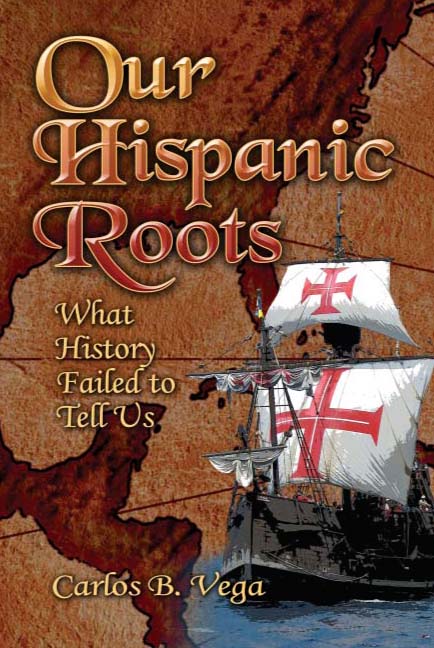
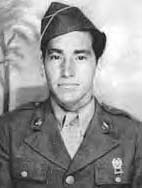 David
M. Gonzales.
Medal of Honor
recipient
David
M. Gonzales.
Medal of Honor
recipient 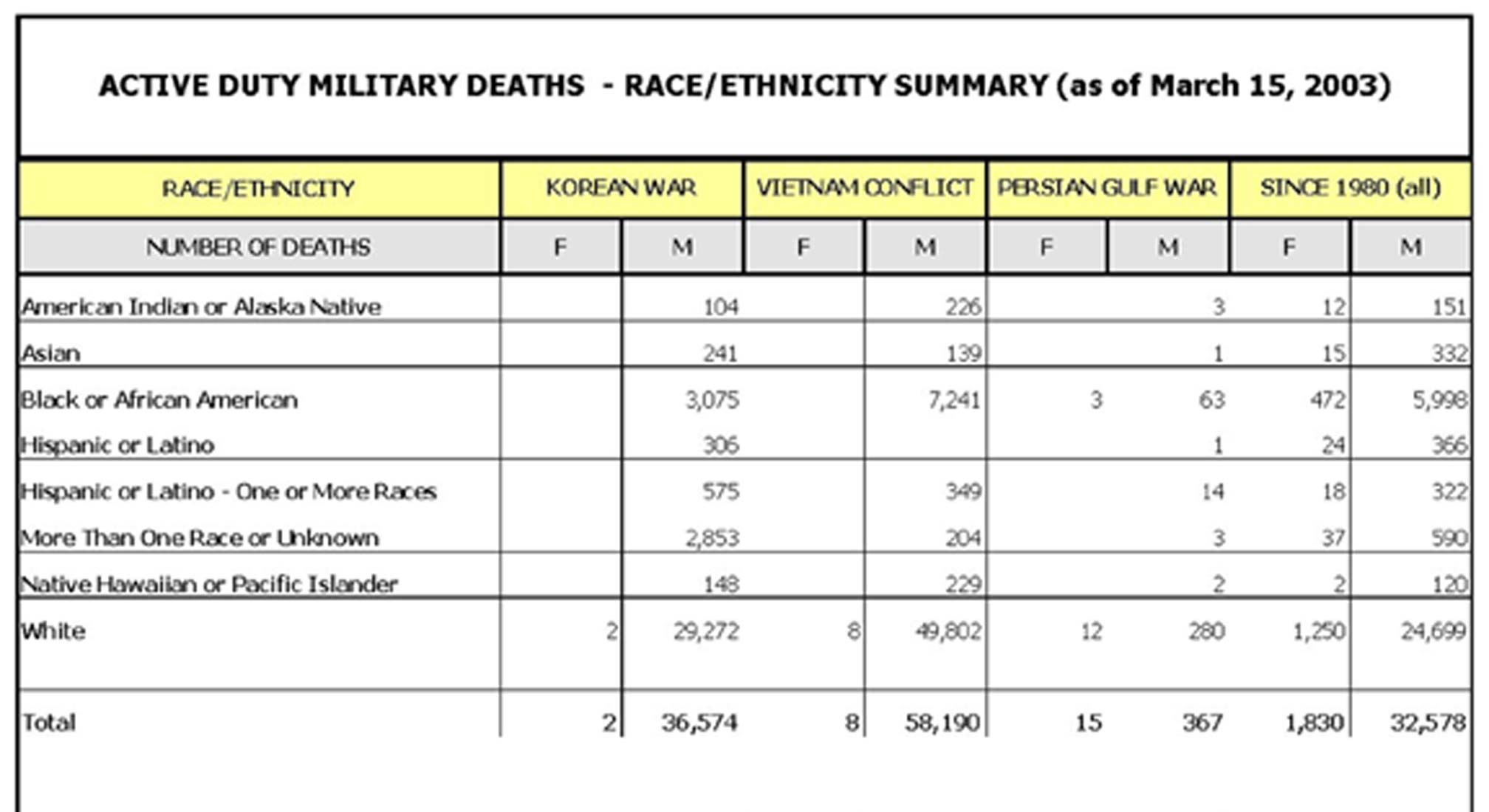
 For
more information:
For
more information: 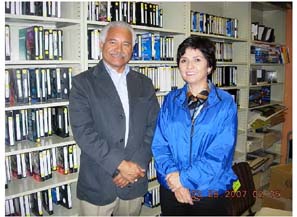

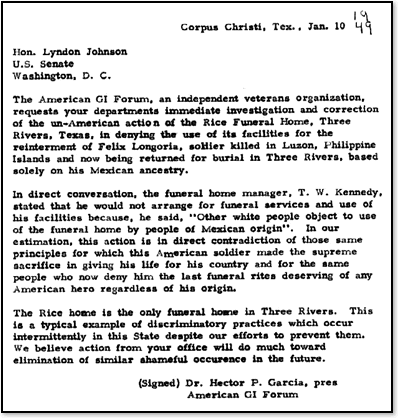
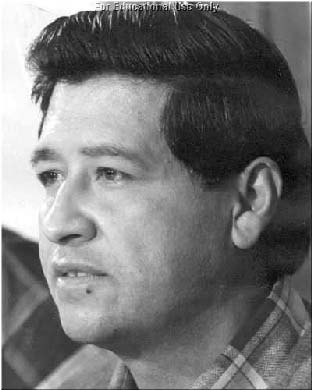
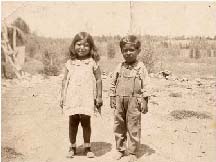 Left,
Cesar Chavez and one of his sisters (Photo
courtesy of the Cesar Chavez Foundation)
Left,
Cesar Chavez and one of his sisters (Photo
courtesy of the Cesar Chavez Foundation)
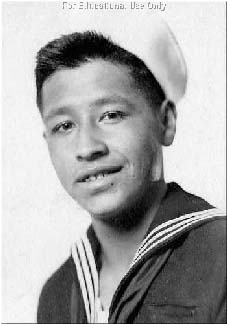 In1944
at seventeen years of age Cesar joined the Navy and served two years
as a deck hand in the Western Pacific. Discrimination was visible
wherever he went. In 1946 Cesar was discharged from the U.S. Navy and
returned to work in the farm fields of California.
In1944
at seventeen years of age Cesar joined the Navy and served two years
as a deck hand in the Western Pacific. Discrimination was visible
wherever he went. In 1946 Cesar was discharged from the U.S. Navy and
returned to work in the farm fields of California.
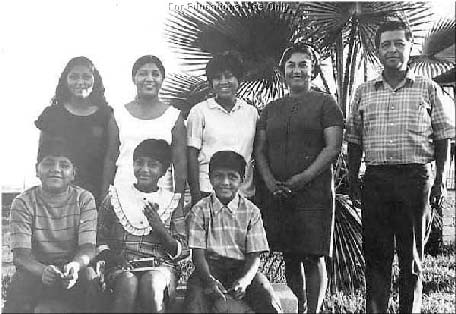
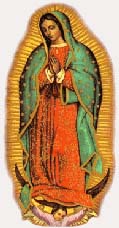
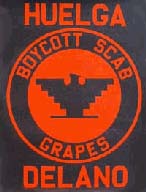
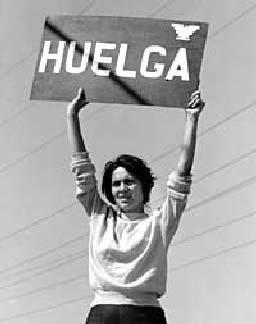
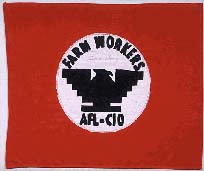 While
Cesar and his wife Helen worked in the fields, Cesar was determined to
improve the living conditions of farm workers. During this time there
were endless farm labor strikes. The farm workers and supporters
carried banners with the black eagle imprinted with the words; HUELGA
(strike) and VIVA LA CAUSA (Long live our cause). These labor strikes
demanded higher wages, better living conditions, and fair hiring
practices from the grape growers.
While
Cesar and his wife Helen worked in the fields, Cesar was determined to
improve the living conditions of farm workers. During this time there
were endless farm labor strikes. The farm workers and supporters
carried banners with the black eagle imprinted with the words; HUELGA
(strike) and VIVA LA CAUSA (Long live our cause). These labor strikes
demanded higher wages, better living conditions, and fair hiring
practices from the grape growers.
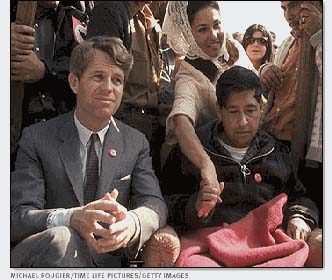 United
States Senator Robert F. Kennedy conducted subcommittee hearings on
agricultural labor. Kennedy had supported the National Farm Workers
Assn., the grape strike, and boycott.
United
States Senator Robert F. Kennedy conducted subcommittee hearings on
agricultural labor. Kennedy had supported the National Farm Workers
Assn., the grape strike, and boycott.
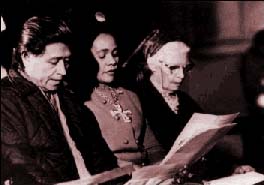
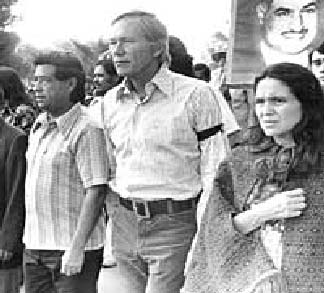 1973 Cesar Chavez began
another grape strike when the UFW’s three year grape contracts came
for up renewal. The contracts were presented to the farmworkers
without any election or representation procedures. Thousands of
strikers were arrested for violating and picketing injunctions,
hundreds were beaten, dozens were shot and murdered.
1973 Cesar Chavez began
another grape strike when the UFW’s three year grape contracts came
for up renewal. The contracts were presented to the farmworkers
without any election or representation procedures. Thousands of
strikers were arrested for violating and picketing injunctions,
hundreds were beaten, dozens were shot and murdered.
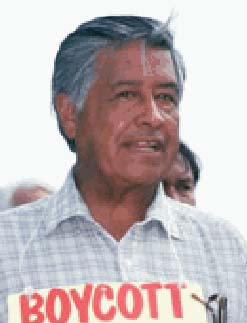 In 1986 Cesar Chavez campaign
of "Wrath of Grapes" focused attention on the use of
pesticides poisoning farmworkers and their children. He led a
five-year nonviolent boycott against California grape growers,
protesting poor working conditions and the use of pesticides.
In 1986 Cesar Chavez campaign
of "Wrath of Grapes" focused attention on the use of
pesticides poisoning farmworkers and their children. He led a
five-year nonviolent boycott against California grape growers,
protesting poor working conditions and the use of pesticides.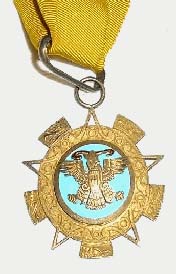
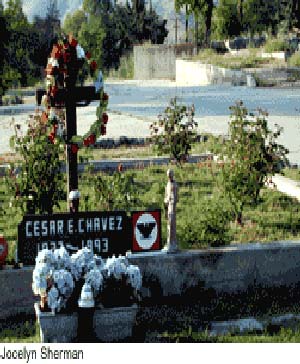
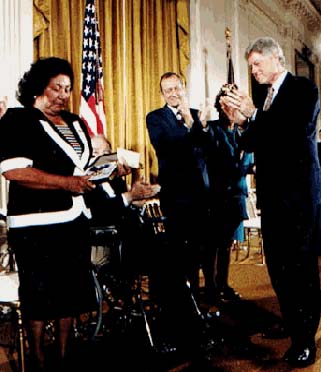 In
September 2, 1994, the Cesar Chavez Holiday bill was signed into law
by California Governor Pete Wilson. It designated March 31 (or the
appropriate Monday or Friday of the following or preceding that date)
as Cesar Chavez Day. It is a California state holiday that promotes
service to the communities of California in honor of Cesar's life and
work throughout the United States there are many schools, parks,
streets, libraries, public facilities, awards, and scholarships named
in honor of Cesar E. Chavez. There is currently a petition in progress
for President Bush to sign and establish Cesar Chavez’ birthday,
March 31st as a National Holiday.
In
September 2, 1994, the Cesar Chavez Holiday bill was signed into law
by California Governor Pete Wilson. It designated March 31 (or the
appropriate Monday or Friday of the following or preceding that date)
as Cesar Chavez Day. It is a California state holiday that promotes
service to the communities of California in honor of Cesar's life and
work throughout the United States there are many schools, parks,
streets, libraries, public facilities, awards, and scholarships named
in honor of Cesar E. Chavez. There is currently a petition in progress
for President Bush to sign and establish Cesar Chavez’ birthday,
March 31st as a National Holiday.
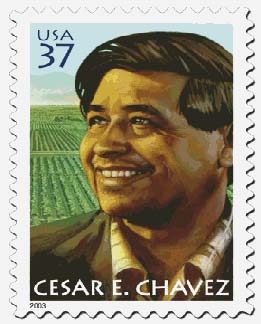 In
September 18, 2002 the United States Postal Service announced plans
for a stamp commemorating Cesar Chavez. Illustrated by Robert
Rodriguez, the unveiling of the proposed thirty seven cent stamp was
unveiled in the U.S. Senate building in Washington D.C. On the
occasion Benjamin Ocasio, Vice President, U.S. Postal Service, stated:
"It is a proud moment for the Postal Service to pay tribute to
this true American hero."
In
September 18, 2002 the United States Postal Service announced plans
for a stamp commemorating Cesar Chavez. Illustrated by Robert
Rodriguez, the unveiling of the proposed thirty seven cent stamp was
unveiled in the U.S. Senate building in Washington D.C. On the
occasion Benjamin Ocasio, Vice President, U.S. Postal Service, stated:
"It is a proud moment for the Postal Service to pay tribute to
this true American hero."

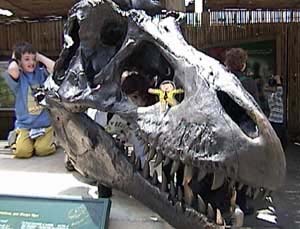
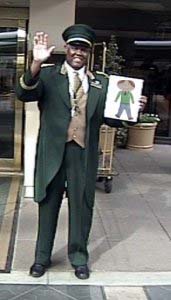
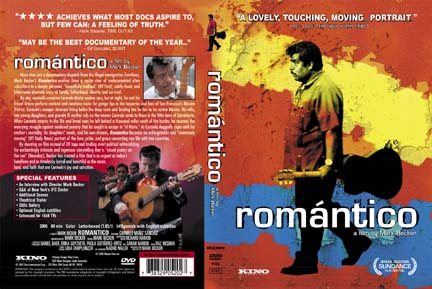
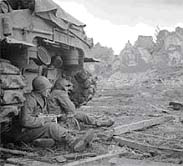
 William Rodriguez, the last man out of the
William Rodriguez, the last man out of the 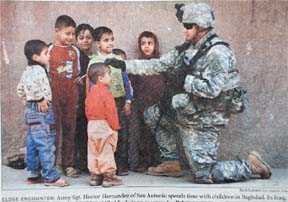
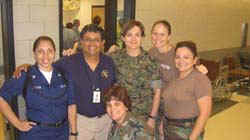
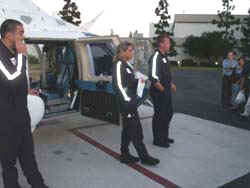 DMATs deploy to
disaster sites with sufficient supplies and equipment to sustain
themselves for a period of 72 hours while providing medical care at a
fixed or temporary medical care site. In mass casualty incidents,
their responsibilities include triaging patients, providing austere
medical care, and preparing patients for evacuation. In other types of
situations, DMATs may provide primary health care and/or may serve to
augment overloaded local health care staffs. Under the rare
circumstance that disaster victims are evacuated to a different locale
to receive definitive medical care, DMATs may be activated to support
patient reception and disposition of patients to hospitals. DMATs are
designed to be a rapid-response element to supplement local medical
care until other Federal or contract resources can be mobilized, or
the situation is resolved.
DMATs deploy to
disaster sites with sufficient supplies and equipment to sustain
themselves for a period of 72 hours while providing medical care at a
fixed or temporary medical care site. In mass casualty incidents,
their responsibilities include triaging patients, providing austere
medical care, and preparing patients for evacuation. In other types of
situations, DMATs may provide primary health care and/or may serve to
augment overloaded local health care staffs. Under the rare
circumstance that disaster victims are evacuated to a different locale
to receive definitive medical care, DMATs may be activated to support
patient reception and disposition of patients to hospitals. DMATs are
designed to be a rapid-response element to supplement local medical
care until other Federal or contract resources can be mobilized, or
the situation is resolved.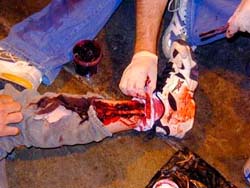 A Disaster Medical
Assistance Team (DMAT) is composed of professional and
paraprofessional medical personnel (supported by a cadre of logistical
and administrative staff) designed to provide emergency medical care
during a disaster or other event. In mass casualty incidents, their
responsibilities include triaging patients, providing austere medical
care, and preparing patients for evacuation. In other situations,
DMATs may provide primary health care or augment overloaded health
care staffs.
A Disaster Medical
Assistance Team (DMAT) is composed of professional and
paraprofessional medical personnel (supported by a cadre of logistical
and administrative staff) designed to provide emergency medical care
during a disaster or other event. In mass casualty incidents, their
responsibilities include triaging patients, providing austere medical
care, and preparing patients for evacuation. In other situations,
DMATs may provide primary health care or augment overloaded health
care staffs.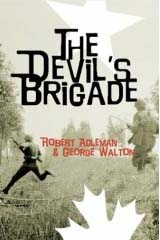 Hi I was reading over your
newsletter.
Hi I was reading over your
newsletter. 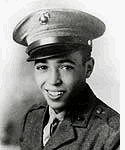
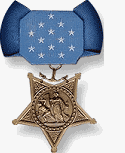
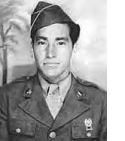
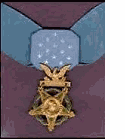

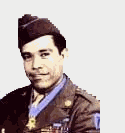
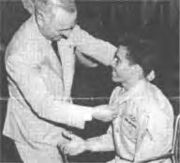
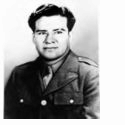
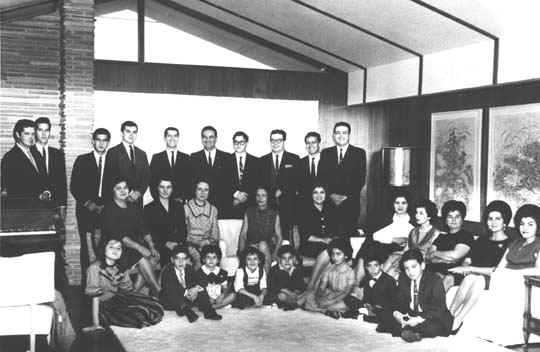
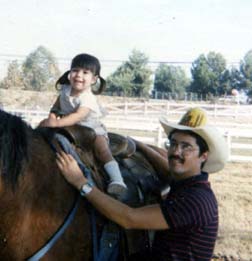
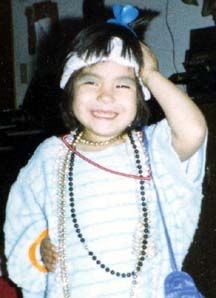
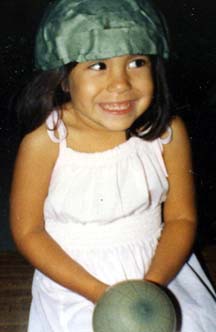
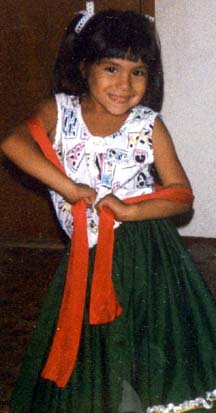
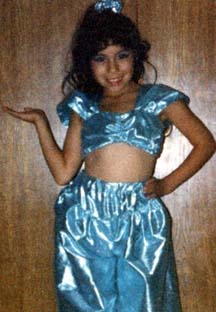 Sometimes I’d leave her inside taking a nap while I worked in the garden and come back inside to find the furniture re-arranged. I don’t know where she found the strength in her tiny body to move the large dressers, but she’d do it, and laugh about it.
Sometimes I’d leave her inside taking a nap while I worked in the garden and come back inside to find the furniture re-arranged. I don’t know where she found the strength in her tiny body to move the large dressers, but she’d do it, and laugh about it.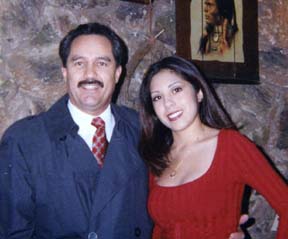
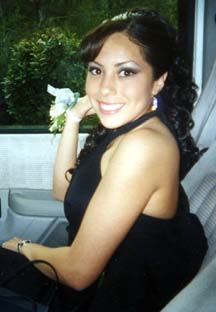 My wife must have noticed my concern, because she sent the kids outside and sat on the couch, motioning for me to sit next to her.
My wife must have noticed my concern, because she sent the kids outside and sat on the couch, motioning for me to sit next to her.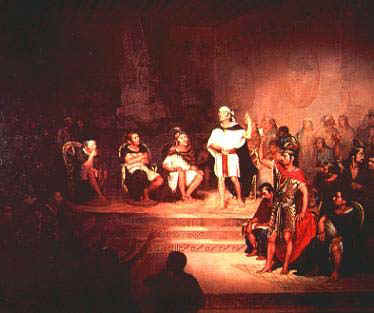
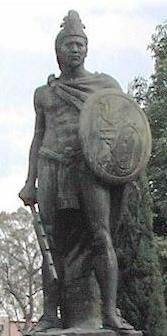
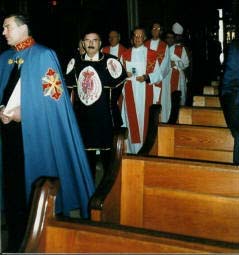
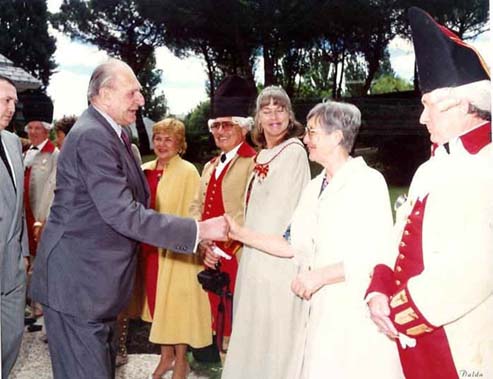

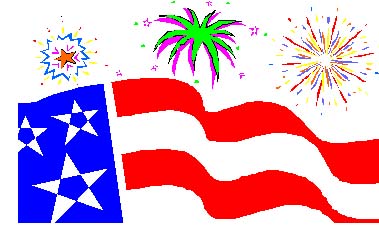
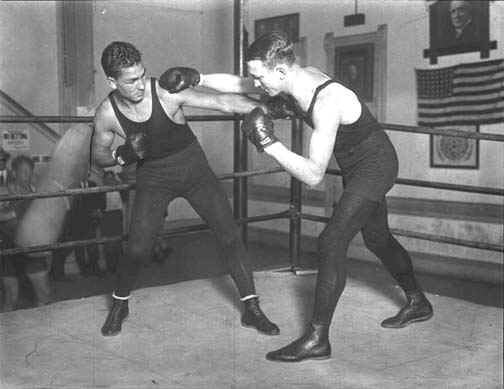
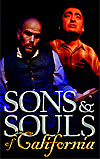
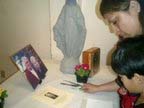 These photos were taken at the Margaret Cruz Memorial at St. Finn's Catholic Church in San Francisco. The late Margaret Cruz who died at her home in San Francisco on Feb. 6 was a long time friend of my mom, Dorinda Moreno.
These photos were taken at the Margaret Cruz Memorial at St. Finn's Catholic Church in San Francisco. The late Margaret Cruz who died at her home in San Francisco on Feb. 6 was a long time friend of my mom, Dorinda Moreno. 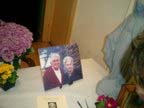 for her small physique but big political fights; she rose in profile in 1960 when co-founded the Mexican American Political
Association.
for her small physique but big political fights; she rose in profile in 1960 when co-founded the Mexican American Political
Association.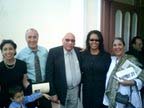
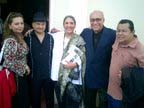
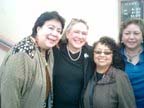
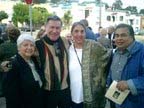
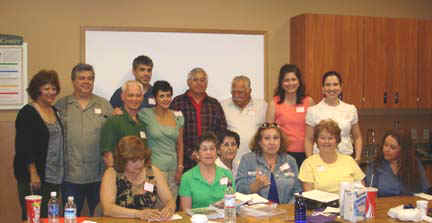
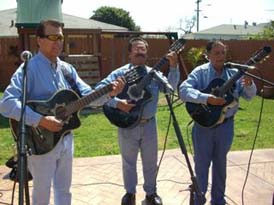
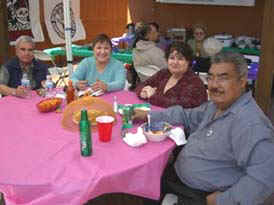
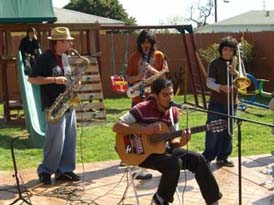
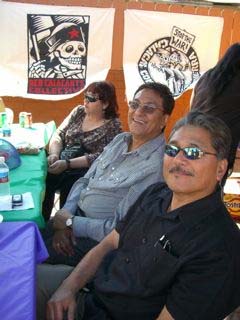
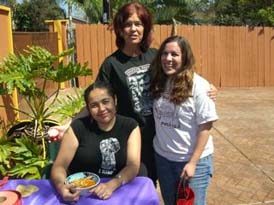
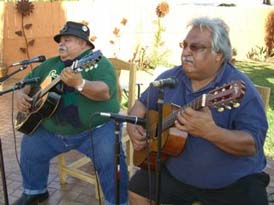
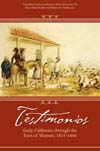 Testimonios:
Early California through the Eyes of Women, 1815–1848
Testimonios:
Early California through the Eyes of Women, 1815–1848 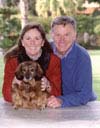 About the
Editors: Rose Marie Beebe and Robert M. Senkewicz teach
Spanish and history, respectively, at Santa Clara University. Together
they are the authors of Lands of Promise and Despair: Chronicles
of Early California, 1535–1846 and the editors of Guide to
Manuscripts Concerning Baja California in the Collections of the
Bancroft Library. They translated and edited The History of
Alta California by Antonio María Osio, and they are
also co-editors of Boletín: The Journal of the California Mission
Studies Association. The couple lives in the San Francisco Bay
Area.
About the
Editors: Rose Marie Beebe and Robert M. Senkewicz teach
Spanish and history, respectively, at Santa Clara University. Together
they are the authors of Lands of Promise and Despair: Chronicles
of Early California, 1535–1846 and the editors of Guide to
Manuscripts Concerning Baja California in the Collections of the
Bancroft Library. They translated and edited The History of
Alta California by Antonio María Osio, and they are
also co-editors of Boletín: The Journal of the California Mission
Studies Association. The couple lives in the San Francisco Bay
Area.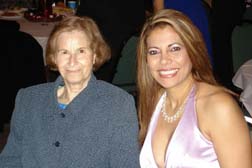
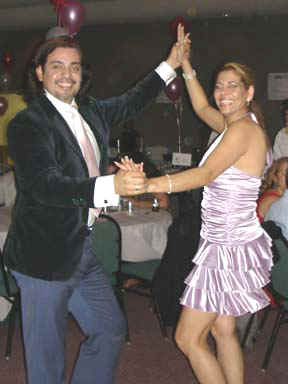
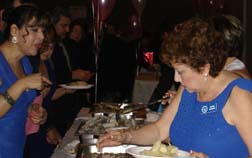

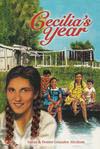 Cecilia's
Year - an historical novel set in the Rio Grande Valley of New Mexico
just after the Great Depression. The novel’s title character struggles
to balance the demands of life on her family’s farm with her ambitions
of education and a life in the big cities she reads about in magazines
and novels. Deeply rooted in the culture and traditions of the American
Southwest,
Cecilia's
Year - an historical novel set in the Rio Grande Valley of New Mexico
just after the Great Depression. The novel’s title character struggles
to balance the demands of life on her family’s farm with her ambitions
of education and a life in the big cities she reads about in magazines
and novels. Deeply rooted in the culture and traditions of the American
Southwest, 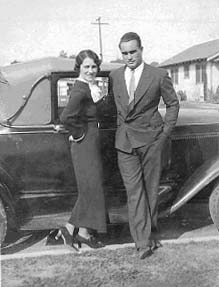 Pearl
was a widow of twelve years when she met the dashing Manuel Lujan Jr.
Pearl
was a widow of twelve years when she met the dashing Manuel Lujan Jr.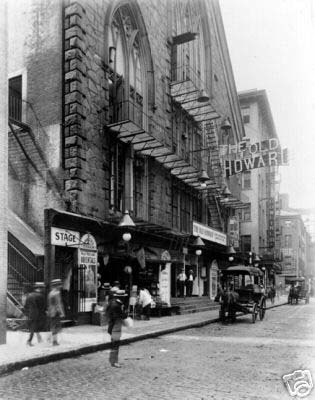
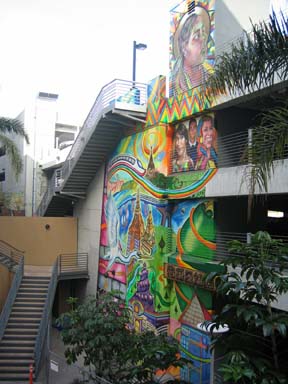
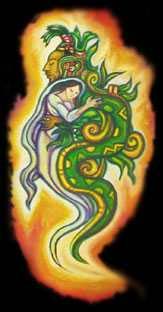 The
legend conceives that the liberating spirit of Quetzalcoatl would arrive in the Promised Land of
Aztlan, presently, the Southwestern United States. From there he would spread throughout the original anscestral lands, reuniting all indigeneous peoples of the Americas.
The
legend conceives that the liberating spirit of Quetzalcoatl would arrive in the Promised Land of
Aztlan, presently, the Southwestern United States. From there he would spread throughout the original anscestral lands, reuniting all indigeneous peoples of the Americas. 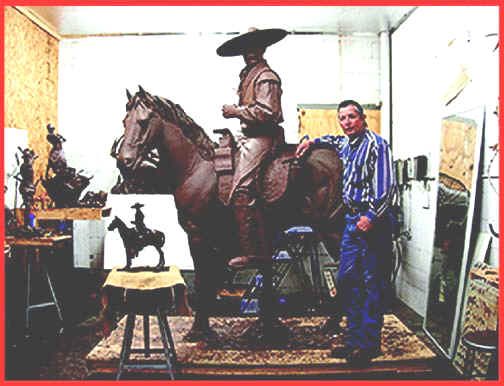

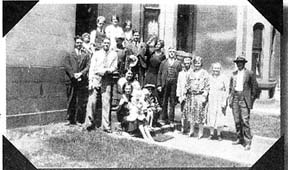 It
is not too often that a newspaper will write an article about one
individual representing a time period in a certain neighbor.
Bonnie McNabb Chapa was fortunate to have photos in order when she was
contacted. Her memories were included as part of a celebration
concerning Lafayette Square, St. Louis, Missouri.
It
is not too often that a newspaper will write an article about one
individual representing a time period in a certain neighbor.
Bonnie McNabb Chapa was fortunate to have photos in order when she was
contacted. Her memories were included as part of a celebration
concerning Lafayette Square, St. Louis, Missouri.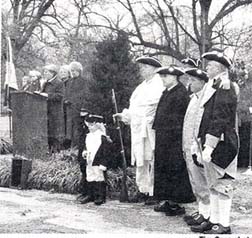
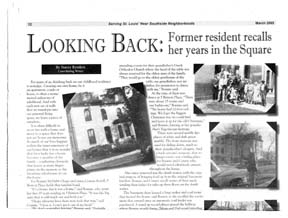
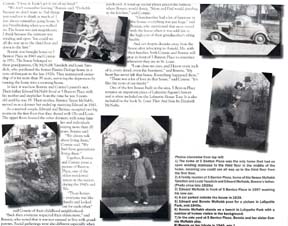

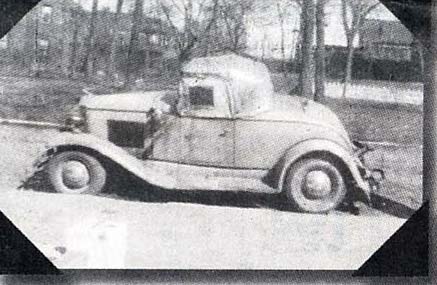
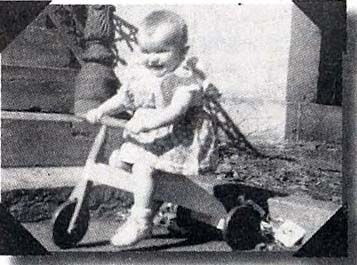
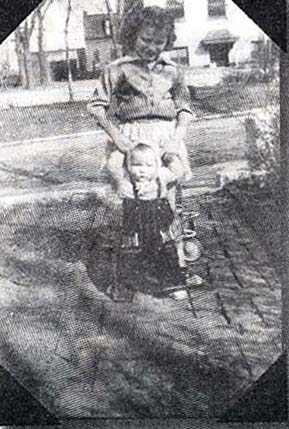
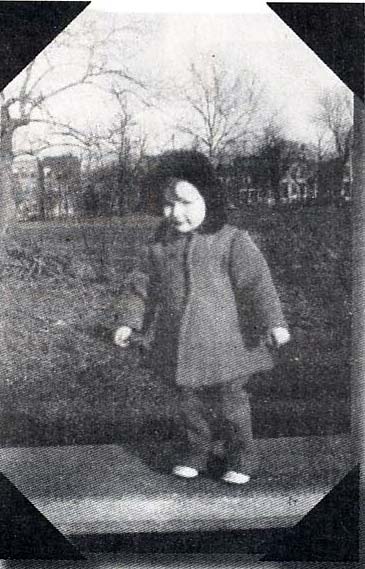
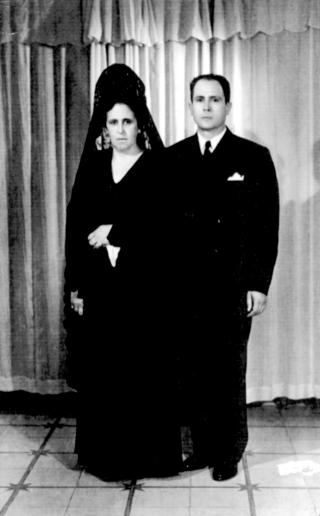
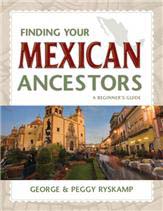 Finding Your Mexican Ancestors:
A Beginner's Guide is essential to any researcher looking to trace their heritage across the Rio Grande. In it, authors George and Peggy Ryskamp show how easy Mexican American research can be by providing detailed descriptions of parish records, civil records, and other types of records common in Mexico.
Finding Your Mexican Ancestors:
A Beginner's Guide is essential to any researcher looking to trace their heritage across the Rio Grande. In it, authors George and Peggy Ryskamp show how easy Mexican American research can be by providing detailed descriptions of parish records, civil records, and other types of records common in Mexico. 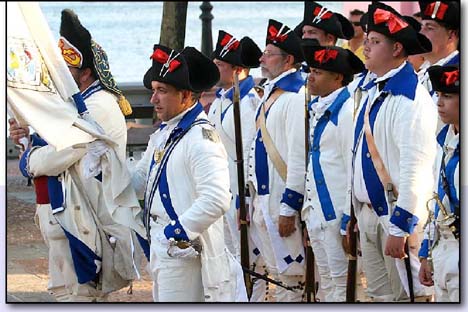

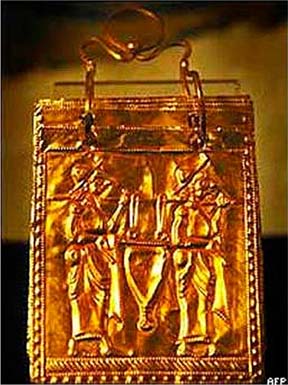 The
world's oldest multiple-page book — in the lost Etruscan language
— has gone on display in Bulgaria's National History Museum in
Sofia. And something about that book has particular interest for
Latter-day Saints.
The
world's oldest multiple-page book — in the lost Etruscan language
— has gone on display in Bulgaria's National History Museum in
Sofia. And something about that book has particular interest for
Latter-day Saints.
